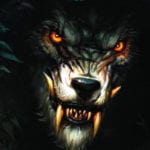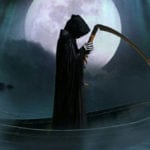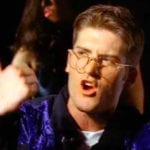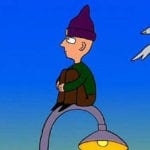 Mysteries
Mysteries  Mysteries
Mysteries  History
History 10 Surprising Stories About the Texas Rangers
 Humans
Humans 10 Philosophers Who Were Driven Mad by Their Own Theories
 Miscellaneous
Miscellaneous 10 Video-Game-Worthy Weapons and Armors from History
 Weird Stuff
Weird Stuff 10 Psychics Who Accurately Predicted Wartime Events
 The Arts
The Arts 10 Pieces of Art Inspired by a Broken Heart
 Health
Health 10 Science Fiction-Sounding New Medical Treatments
 History
History 10 Surprising Facts About the Father of Submarine Warfare
 Space
Space Ten Astonishing New Insights into Alien Worlds
 Weird Stuff
Weird Stuff 10 Bizarre Summer Solstice Rituals Still Practiced Today
 Mysteries
Mysteries Top 10 Haunting Facts About the Ghost Ship MV Alta
 History
History 10 Surprising Stories About the Texas Rangers
 Humans
Humans 10 Philosophers Who Were Driven Mad by Their Own Theories
Who's Behind Listverse?

Jamie Frater
Head Editor
Jamie founded Listverse due to an insatiable desire to share fascinating, obscure, and bizarre facts. He has been a guest speaker on numerous national radio and television stations and is a five time published author.
More About Us Miscellaneous
Miscellaneous 10 Video-Game-Worthy Weapons and Armors from History
 Weird Stuff
Weird Stuff 10 Psychics Who Accurately Predicted Wartime Events
 The Arts
The Arts 10 Pieces of Art Inspired by a Broken Heart
 Health
Health 10 Science Fiction-Sounding New Medical Treatments
 History
History 10 Surprising Facts About the Father of Submarine Warfare
 Space
Space Ten Astonishing New Insights into Alien Worlds
 Weird Stuff
Weird Stuff 10 Bizarre Summer Solstice Rituals Still Practiced Today
Top 10 TV Theme Songs from the 1960s
By the 1960s, America’s television industry had matured as its technology rapidly advanced in visual quality. Dingy black and white shows produced in the 1950s as kinescopes (by filming the screen of a television monitor) transitioned to vivid “in living color” shows by the mid-1960s. The sheer number of shows exploded. Inventive concepts and storylines in situation comedies flourished. Westerns and fantasy series became far less formulaic. Writers of police procedurals and medical dramas addressed serious societal themes convincingly.
Millions of Americans watched and enjoyed these shows. As a result, ad revenues skyrocketed. Television production companies and national broadcast networks were flush. They were able to spend real money to attract the best directors, writers, and actors. And they didn’t neglect music. Companies developed teams of powerfully creative songwriters and arrangers. The result was an astonishing burst of musical creativity in the writing and performing of TV theme songs. Some songs became so popular that they hit the top of the pop charts. When people of a certain age hear the first few notes of one of these songs today, they immediately recognize the song and fondly remember their favorite childhood TV show.
So sit back and enjoy as we wander back in time to reveal the top 10 TV theme songs from the 1960s.
Related: 10 Surprising Musical Moments From Popular Shows
10 Mister Ed, 1961–1966
Mister Ed depicts the misadventures of a wisecracking, prank-pulling, talking palomino, voiced by Allan Lane. Wilbur Post, played by Alan Young, is his good-natured, klutzy owner. Only Willlllburrrr could hear Mister Ed talk. Wilbur’s wife felt put upon as her husband seemed to spend more time with the horse than her. This light-hearted contemporary fantasy was based on stories written by children’s author Walter R. Brooks and published in magazines in the 1930s and 1940s.
Just before the song begins, the horse opens his stall and introduces himself in a majestic bass tone, “Hello. I’m Mister Ed.” The opening line begins: “A horse is a horse, of course, of course.” This song is built upon the beat of a trotting horse. Famed songwriting team Ray Evans and Jay Livingstone wrote the song. Livingstone made a demo of the song, singing it in a mellow pop song style. He assumed a professional singer would be hired to give it more polish. However, the producer liked Livingstone’s version so much that the song was never re-recorded for the show.
Shockingly in 1986, for such a sweet-tempered show, a preacher claimed he could hear Satanic messages when he played the song backward. Teenage followers burned copies of recordings of it. Other people examined the recording. Thank goodness no one ever found evidence of any kind of embedded message within the song.[1]
9 I Dream of Jeannie, 1965–1970
In another contemporary fantasy, Barbara Eden played a beautiful genie, and Larry Hagman played Captain Tony Nelson, an astonished and bewildered astronaut. The show title gives a nod to Stephen Foster’s famous song, “Jeanie with the Light Brown Hair.” Richard Wess wrote an instrumental, a simple waltz, used at the beginning of the first few episodes of the first season. This song accompanied Friz Freleng’s animation of the bottle releasing the actors’ names into the air and Jeannie dancing. At the beginning of episodes 2-8 that season, Paul Frees intoned, in a humorous allusion to fairy tales, a description of Tony Nelson as living “in a mythical town called Cocoa Beach in a mythical state called Florida.”
Producer Sidney Sheldon decided the show needed a new theme song. Hugo Montenegro and Buddy Kaye wrote the iconic samba for seasons two through five. The animation for the credits was reworked. We see Tony’s space capsule splash down near a beach where Jeannie’s bottle lay unopened for 2,000 years. When he opens the bottle, smoke pours out and turns into the dancing Jeannie.[2]
8 Get Smart, 1965–1970
It was the mid-sixties, and James Bond and Inspector Clouseau were all the rage. Producer Dan Melnick decided it was high time he created a spoof of spy movies for television. Mel Brooks agreed to head up the project. He would later use his earnings to finance his first movie, The Producers. Buck Henry was hired to write Mel’s ideas down on paper, including the shoe phone and the Cone of Silence. After the pilot episode, Buck became the head writer, rewriting every script to get the characterizations and the tone just right. Don Adams signed on when he heard who wrote the scripts. He had been a combat Marine who fought in the South Pacific during World War II and later became a drill instructor. But he handled the humor superbly with his stiff intonations and the silly bits, including the famous running gag, “Would you believe…?”
The theme song, an instrumental constructed as a military march, features trumpets blaring the first four notes of each musical line with authority. Fans never forgot those notes. A drum would sound as each set of giant security doors slammed shut behind Maxwell Smart as he moved deeper into the bowels of Control headquarters. The opening credits rolled during this bit of spy silliness. The song was composed and directed by Irving Szathmary, the brother of the famous comic Bill Dana. The theme song fit the premise of a spy spoof perfectly. When Smart dropped out of sight in the phone booth at the end of the song, this action was supposed to indicate the presence of a secret elevator in operation. But Don Adams merely dropped to his knees quickly behind a darkened panel.[3]
7 Bewitched, 1964–1972
A witch, Samantha, played by Elizabeth Montgomery, marries a mortal, Darrin, played by Dick York and later by Dick Sargent. Poor Darrin suffers from unusual in-law problems with Endora, Samantha’s mother, played by Agnes Moorehead. Endora hates the fact that Samantha married a mortal and is determined to break up the marriage. Samantha’s father, Maurice, also puts in the occasional appearance. He holds forth on his love of the theater and how he had known Shakespeare personally. Bewitched was slightly controversial in its time. It was the first TV show in which a couple shared a bed!
The show was originally set to use Frank Sinatra’s “Witchcraft” as its theme song, but the producers didn’t want to pay royalties. So they decided to use the song “Bewitched.” The songwriting team of Howard Greenfield and Jack Keller had written it with lyrics, but these were omitted from the theme song version. Warren Barker arranged the light orchestral version of the song featuring “lots of bells.” We see an animated Samantha flying a broomstick which writes the word “Bewitched” in the starry sky above the city. The bubbly song includes a xylophone to accompany Samantha’s famous nose twitch with which she casts spells. The same sound was used during the show itself.[4]
6 Gilligan’s Island, 1964–1967
Klutzy Gilligan and his exasperated Skipper take five passengers from a tropic port on a three-hour tour, which is rudely interrupted by a storm. This is how a great premise song, “The Ballad of Gilligan’s Island,” explains how these seven people came to live on a desert island. Sherwood Schwartz and George Wyle wrote this wonderful theme song in the spirit of an old sea shanty. Here’s one neat bit of trivia about the lyrics. Bob Denver, who starred as Gilligan, was dissatisfied with how the characters were listed near the song’s end. The first five characters are named or described: “Gilligan, the Skipper too, the millionaire and his wife, the movie star…” Denver asked the songwriters to switch “and the rest” to “the professor and Mary Ann” in the second season of the show so everyone would receive equal billing. [5]
5 The Jetsons 1962-–1963
The first four notes of the vocals in Hoyt Curtin’s classic, “Meet George Jetson,” were so iconic they became a doorbell chime. It’s a bright, happy song. Except for the very beginning, when strings play a “Gosh! Wow!” futuristic theme while the animation shows the galaxy and then Earth, the melody could’ve been used for any ’60s situation comedy. During the song, we see and hear the members of the family being introduced, with George piloting his flying car, dropping off his children and wife—literally—to their schools and a shopping center. A bit of musical humor is introduced near the end of the song with a few piano measures of “Chopsticks.” George arrives at the office, folds up his car into a briefcase, rides a conveyor belt, hops into his chair, and puts his legs up on the desk at Spacely Sprockets, where his boss, no doubt, was waiting impatiently for him. Mr. Spacely was voiced by Mel Blanc, the greatest comedic voice in animation history.
We of the 21st century are now moving rapidly into the Jetsons’ future. According to die-hard fans, George Jetson was born on July 31, 2022! The show was set 100 years after the early 1960s, so this birthday would make George the middle-aged dad as depicted on the show. Even though it was a cartoon, historian Matt Novak considers the show the single most important depiction of the future in 20th-century entertainment media. It takes space colonization to be an established fact, one never questioned during the show.[6]
4 The Beverly Hillbillies, 1962–1971
“The Ballad of Jed Clampett” is another great “explain the premise” TV theme song. How did a hillbilly move his family to a mansion in Beverly Hills? Welllllll, ol’ Uncle Jed was “a shootin’ at some food when up from the ground came a bubbling crude.” Yes, he struck it rich in oil. Kinfolk said, “Californy is the place ya oughtta be.” And so, he and his family moved. And then a cultural clash ensued.
As a result of this song, no one ever forgot the meaning of the phrases “black gold” and “Texas tea.” The song was written in a country-western style by Paul Henning and was performed by the superb bluegrass band Flatt & Scruggs. It became a hit on the country charts in 1962.[7]
3 The Addams Family, 1964–1966
A humorously spooky family was the strangest show to air on TV at the time. No one had ever seen anything like it. Children loved the antics of the extended family, including Frankenstein’s monster, a witch, Uncle Fester, Morticia, two odd children, a hairball (Cousin It), a pet lion (Kitty Cat), and a disembodied hand (Thing). John Astin played the almost normal patriarch, Gomez Addams. The humor grew out of the conceit of the family, who saw themselves as perfectly normal with respect to the world. Cultural clashes happened each week when “people came to see ’em.” The show was based on a series of cartoons published in The New Yorker by Charles Addams, who, unfortunately, had problems getting his cartoons published after the show aired.
The theme song famously begins with a harpsichord repeatedly playing four notes followed by two finger snaps. So recognizable is this musical signature that organists at major league baseball games still play it to this day. The vocals feature three rhyming words per line, “They’re creepy, and they’re kooky, mysterious and spooky, they’re altogether ooky, the Addams Family.” The producers had planned on making the butler character, Lurch, always silent, but Ted Cassidy insisted that his character would have to speak. And so, he did in his famous growl: “You raaaang” In full-Lurch form, Cassidy was able to contribute to the theme song, voicing amusingly terse and misleading descriptions of three fellow characters, “Sweet. Neat. Petite.” Vic Mizzy, the veteran TV composer, wrote and arranged it, ultimately achieving musical immortality.[8]
2 Hawaii Five-0, 1968–1980
This show was considered the ultimate police-procedural by TV critics. Its unusual setting in Hawaii made it a visual treat. Jack Lord starred as the stern Captain Steve McGarrett, who led the Five-0 team. The name of the task force was taken from Hawaii’s historical status as the nation’s 50th state. The theme song, an instrumental, was composed by Morton Stevens and performed by The Ventures, perhaps the best instrumentalist rock band ever. The song became a huge radio hit, reaching number 4 on the Billboard charts in 1968. It’s a fast-paced song reminiscent of surfing songs of the era, perfect for setting the mood for an adventure in Hawaii.
We see the big wave curling in as the song begins. Then we see the places and people of Hawaii, and the members of the team, including Chin Ho and Kono. Sammy Davis, Jr., Don Ho, and Bill Murray all performed vocal versions of the song at some time. “Book ’em, Danno” was the order McGarrett gave Detective Sergeant Danny Williams, played by James MacArthur, when the case was wrapped up at the end of the hour. It became so iconic comedians spoofed it, and other TV police procedurals borrowed it.[9]
1 Mission: Impossible, 1966–1973
This superbly crafted show was the ultimate Cold War-era drama. The Impossible Missions Force would devise and carry out intricate plots to foil the bad guys, both foreign and domestic. Often minutes would go by with no dialogue as Force members would execute their roles in tense situations. Unusual camera angles, borrowed from movie directors, would intensify the drama. Dan Briggs, played by Steven Hill, served as the head of the IM Force during the first season. Peter Graves, brother of the even more famous actor James Arness, took over the leadership role of Jim Phelps for the rest of the run of the show.
Mission: Impossible may have been blessed with the best TV theme song ever. The melody is impossible to forget. It was composed by Lalo Schifrin as an instrumental in unusual 5/4 time and was performed by a full orchestra, enlivened by bongos. It begins with the rapid tootling of a flute. An animated fuse is lit. Violins begin playing the iconic melody as the fuse burns. The song and animation promise a great adventure to the viewer. When word came out that Tom Cruise would star in the first Mission: Impossible movie, rumors spread that the producers were uninterested in using the TV theme song. Fan outrage quickly caused them to change their minds. It didn’t hurt that Cruise loved the song.[10]








